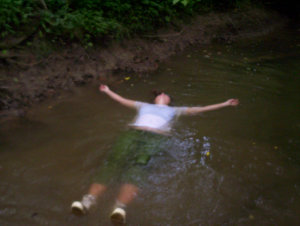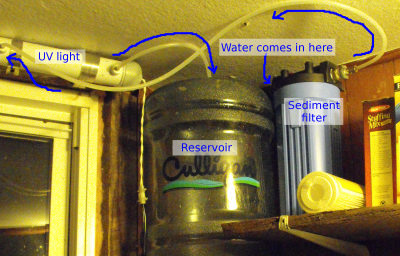
Drinking water question
--- Dennis, Florida
 Our property is rich in water, but none of it
is safe to drink. We have two creeks which work great for
irrigating the garden and a hand-dug well which people presumably drank
from decades ago. Unfortunately, the well tested positive for
coliform bacteria.
Our property is rich in water, but none of it
is safe to drink. We have two creeks which work great for
irrigating the garden and a hand-dug well which people presumably drank
from decades ago. Unfortunately, the well tested positive for
coliform bacteria.
Coliform bacteria, while not necessarily dangerous by themselves, are a
sign that the water has come in contact with the fecal matter of a
mammal at some point, and thus mean the water isn't safe to
drink. Many people who drink from shallow wells or springs build
up an immunity to the problematic bacteria, but we didn't want to risk
it, especially since it would mean that guests might get sick drinking
our water. So, for the first year and a half, we carried our
drinking water into the property a gallon at a time from a friend's
house a mile down the road.
Then came the economic stimilus checks this spring. We decided to
see if we could get our drinking water system up and running for a
couple of hundred bucks, and sure enough we did!
After researching all of the options, I quickly decided that a UV light
is the best treatment system for home drinking water --- actually, a
lot of municipal water treatment plants are moving toward UV treatment
and away from chlorine since UV is completely safe and leaves no nasty
aftertaste. The cheapest UV system I came across was the Omnipure
Pacific from FreshWaterSystems.com. We opted for the 1 gpm 6
watts sytem with ballast, and bought an extra light since the light has
to be changed about once a year.
 The one thing you have to be aware of when
installing a UV treatment system is that the water needs to be very
clear for the system to be effective. Any tiny grains of dirt
suspended in the water will act as a shield, protecting bacteria from
the light and making the "treated" water unsafe. The bare minimum
is to install a 5 micron sediment filter upstream of the UV light
system so that the water runs through the sediment filter and is
cleaned before running through the UV system. You can get
sediment filters just about anywhere, but we got ours from the same
place to save on shipping. In the end, our treatment system cost
under $200.
The one thing you have to be aware of when
installing a UV treatment system is that the water needs to be very
clear for the system to be effective. Any tiny grains of dirt
suspended in the water will act as a shield, protecting bacteria from
the light and making the "treated" water unsafe. The bare minimum
is to install a 5 micron sediment filter upstream of the UV light
system so that the water runs through the sediment filter and is
cleaned before running through the UV system. You can get
sediment filters just about anywhere, but we got ours from the same
place to save on shipping. In the end, our treatment system cost
under $200.
Another thing you should consider when installing a water treatment
system is your water source. The system I've outlined here (and
also the systems used to treat most municipal drinking water) are
designed to remove only sediment and microorganisms. If you pump water from a creek which gets
pesticide runoff, the pesticides will still be in the water after you
treat it! So you're far better off starting off with
groundwater (from a well or spring) and preferably also using water
from a watershed which is completely forested.
We made one change from the normal installation procedure. While
most people would install a pressure tank which automatically kicks on
the well pump whenever it gets low and leave the UV light plugged in at
all times, we opted for a cheaper and lower power system. Mark
rigged up a reservoir above the kitchen sink to hold our drinking
water. Once a day or so, we flip the switch on the power strip
which turns on the UV light and well pump and lets the water rush
through the sediment filter and UV system to fill up the
reservoir. Then we turn off the power strip until the next
day. Used this way, we suspect our UV light will last for several
years instead of just the one promised by the manufacturer. And
now we have clean, running, drinking water piped to our kitchen
sink! No more carrying frozen jugs of water for half a mile to
the house in the winter.
Want more in-depth information? Browse through our books.
Or explore more posts by date or by subject.
About us: Anna Hess and Mark Hamilton spent over a decade living self-sufficiently in the mountains of Virginia before moving north to start over from scratch in the foothills of Ohio. They've experimented with permaculture, no-till gardening, trailersteading, home-based microbusinesses and much more, writing about their adventures in both blogs and books.
Want to be notified when new comments are posted on this page? Click on the RSS button after you add a comment to subscribe to the comment feed, or simply check the box beside "email replies to me" while writing your comment.
- Remove comment
- Remove comment
